Nukeproof introduced the Giga, its ‘super enduro’ bike, back in January 2021, offering it to riders who wanted something a little more than the Mega, which was, at the time, the longest-travel bike the brand made aside from its full-blown downhill bike, the Dissent.
With up to 180mm of rear-wheel travel (on the 27.5in version, or 170mm on the 29er), a frame based around its downhill bike and some properly up-to-date geometry, the intentions for the Giga were clear from the get-go.
But many asked why the Belfast-based brand wanted to launch another enduro bike – wouldn’t the Giga just tread on the Mega’s toes?
When it comes to our annual Bike of the Year test, the Mega has proven itself time and time again over the last few years, but never managed to take top spot.
That's now changed with the Giga – our Enduro Bike of the Year winner for 2022.
So, how has the Giga finally managed to clinch the title for Nukeproof? What’s so special about it compared with the other seven Enduro Bike of the Year contenders? Read on to find out.
Nukeproof Giga 297 Carbon Elite frame and suspension details

The Giga is now offered in all the conceivable wheel combinations currently available (27.5in, 29in or mixed with a 29in up front and 27.5in at the rear).
I tested the 297, which refers to the mixed-wheel size or mullet bike.
Nukeproof only makes the Giga from carbon, partly down to the scope it gives when it comes to tuning frame stiffness, and partly down to the complex down-tube shape it has created in order to fit a bottle cage.

Look closely and you’ll see the cage is sunk down into the upper side of the down tube in order to create the clearance required to fit a bottle in the front triangle.
This does, however, mean pricing for the Giga can’t start as low as the Mega, which does have alloy frame options.
Controlling all that travel
The single-pivot, linkage-actuated suspension design delivers, in the case of the 297 seen here, 180mm of rear-wheel travel.
Nukeproof has cleverly managed to add in some adjustment at the main pivot, enabling you to alter how progressive the Giga’s rear suspension is.

The eccentric-pivot axle system allows the Giga to be switched from 25.5 per cent to 29 per cent progression, and changing between the two is quick and easy. That level of tuning means the Giga can easily accommodate a coil shock that requires more progression, or simply help to firm things up when riding mellower trails or smooth jump lines.
When it comes to axle path, Nukeproof claims to have made the Giga’s move backwards initially in a bid to help the bike hold speed when ploughing into really rough sections. It only moves back by 2.5mm in the first 50mm of travel, though, before continuing to arc upwards and forwards for the remainder of its travel.
A big bike with all this travel is all well and good on the descents, but this rig is designed to be pedalled uphill, too. In the climbing gear (32-50t) and in the lower of the two progression settings, anti-squat is claimed to be 96 per cent.
Eye for detail

It’s fair to say that Nukeproof sweated the details here. While working on bikes with internal cabling can be a pain, for example, it’s reassuring to see that the Giga comes with fully tubed internal channels to make life a little easier.
A threaded bottom bracket may also help to keep maintenance that bit simpler.
Meanwhile the SRAM Universal Derailleur Hanger (UDH) should be widely available if and when you’re in need of one, a fact that may come in handy if you’re away at a race.
For those who live in damper climates, where muddy trails are the norm, you’ll be pleased to know there’s sufficient clearance for a 2.6in rear tyre, which should mean you’ll be able to keep a 2.4in tyre, caked in mud, spinning without too much hassle.
All pivots use EnduroMAX bearings, too, and there’s a neat little rear mudguard, which should help to keep grime off the linkage (a bit, at least).
Finally, alongside the bottle cage, additional mounts are included on the underside of the top tube, allowing you to bolt essentials such as a tube, tyre levers and a C02 inflator to the frame.
Nukeproof Giga 297 Carbon Elite geometry
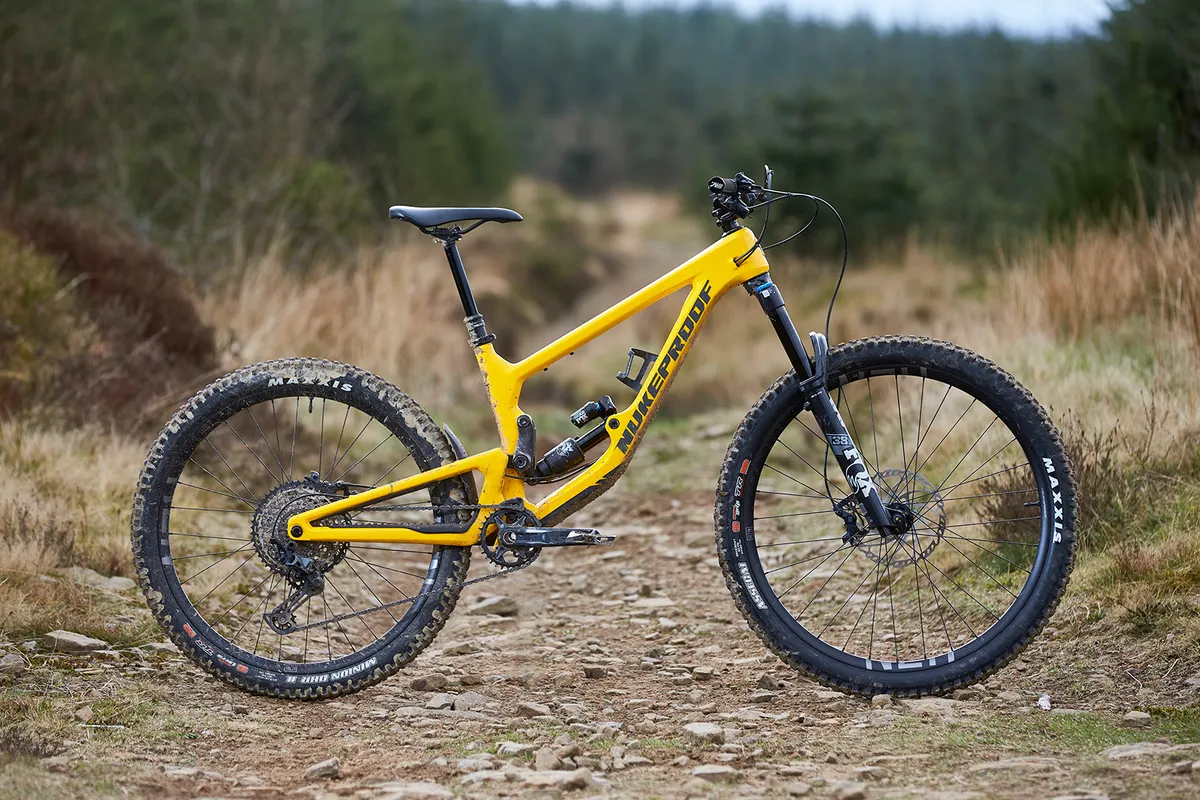
Although Nukeproof offers the Giga in the 27.5in and 29in version in five different frame sizes, if you’re looking at the mixed-wheel size option, it’s worth noting that there are only three size options to choose from (small, medium and large).
Nukeproof has done a sterling job when it comes to the numbers. Or at least, I think it has, especially on the medium frame I’ve been testing.
The reach measurement (the horizontal distance from the centre of the bottom bracket to the centre of the head tube, giving an indication of how a bike will feel when you’re standing up out of the saddle) measures in at 455mm. This is on par with many of the Giga’s closest competitors.

In a bid to help keep the bike stable at speed, the head angle stands at a slack 63.4 degrees. This gives the medium bike a front centre (a measurement taken from the centre of the bottom bracket to the centre of the front axle) of 800mm.
That’s matched with a rear centre (or effective chainstay length) of 438mm.
The all-important seat angle (measured with the saddle set to my preferred pedalling height of just under 700mm from the centre of the bottom bracket to the top of the saddle) is steep, at 78 degrees. This should help promote a nice and efficient seated position on the bike.
I measured the bottom bracket lower than quoted on the Nukeproof website, at 340mm off the floor. With so much of the frame’s mass slung low in the frame and a low bottom bracket, this should make for a confident bike through the turns.
| | S | M | L |
|---|---|---|---|
| Seat angle (degrees) | 77.75 | 77.75 | 78 |
| Head angle (degrees) | 63.5 | 63.5 | 63.5 |
| Chainstay (mm) | 435 | 435 | 435 |
| Seat tube (mm) | 380 | 410 | 440 |
| Top tube (mm) | 565 | 590 | 609 |
| Head tube (mm) | 100 | 100 | 110 |
| Fork offset (mm) | 42 | 42 | 42 |
| Trail (mm) | 136 | 136 | 136 |
| Bottom bracket drop (mm) | 25 | 25 | 25 |
| Bottom bracket height (mm) | 350 | 350 | 350 |
| Wheelbase (mm) | 1206 | 1231 | 1256 |
| Standover (mm) | 703 | 710 | 730 |
| Stack (mm) | 622 | 622 | 631 |
| Reach (mm) | 430 | 455 | 475 |
Nukeproof Giga 297 Carbon Elite specifications
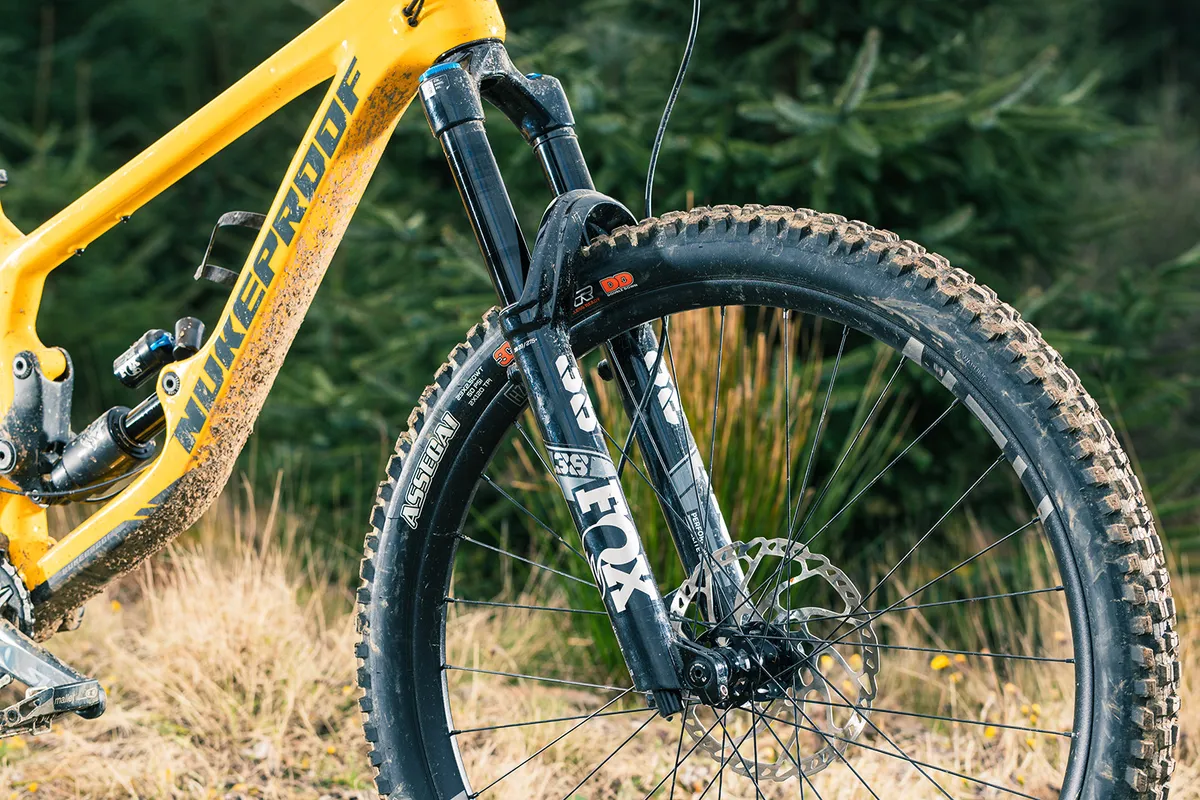
Let’s start with the suspension. Both the fork and shock come from Fox’s Performance Elite range. The fork, in this case, is the 38 Performance Elite, which uses the brand’s GRIP2 damper, complete with high- and low-speed compression and rebound damping. Unlike the Factory equivalent of the fork, there are no golden, Kashima-coated upper fork legs here, though.
Similarly, the shock comes with a decent amount of adjustment (low-speed compression and rebound) and also gets a low-speed compression lever to firm it up when you’re climbing.
The Shimano SLX gearing might sound a bit of a budget choice on a bike at this price, but Shimano tends to do a seriously good job of making its cheaper kit work almost as well as the high-end offerings. The 12-speed SLX drivetrain is no different and works brilliantly with a wide enough range thanks to the 10-51t cassette.
My test bike arrived with a slightly inconsistent feel to the rear brake, with the bite point wandering quite dramatically as I rode.

Thankfully, a fresh bleed managed to sort it out and from that point on, both front and rear brakes felt nicely consistent.
I’ll never write a bike review without commenting on tyres, simply because they are critically important to a bike’s performance. Nukeproof has always listened over the years and seems keen to improve when and where it can.
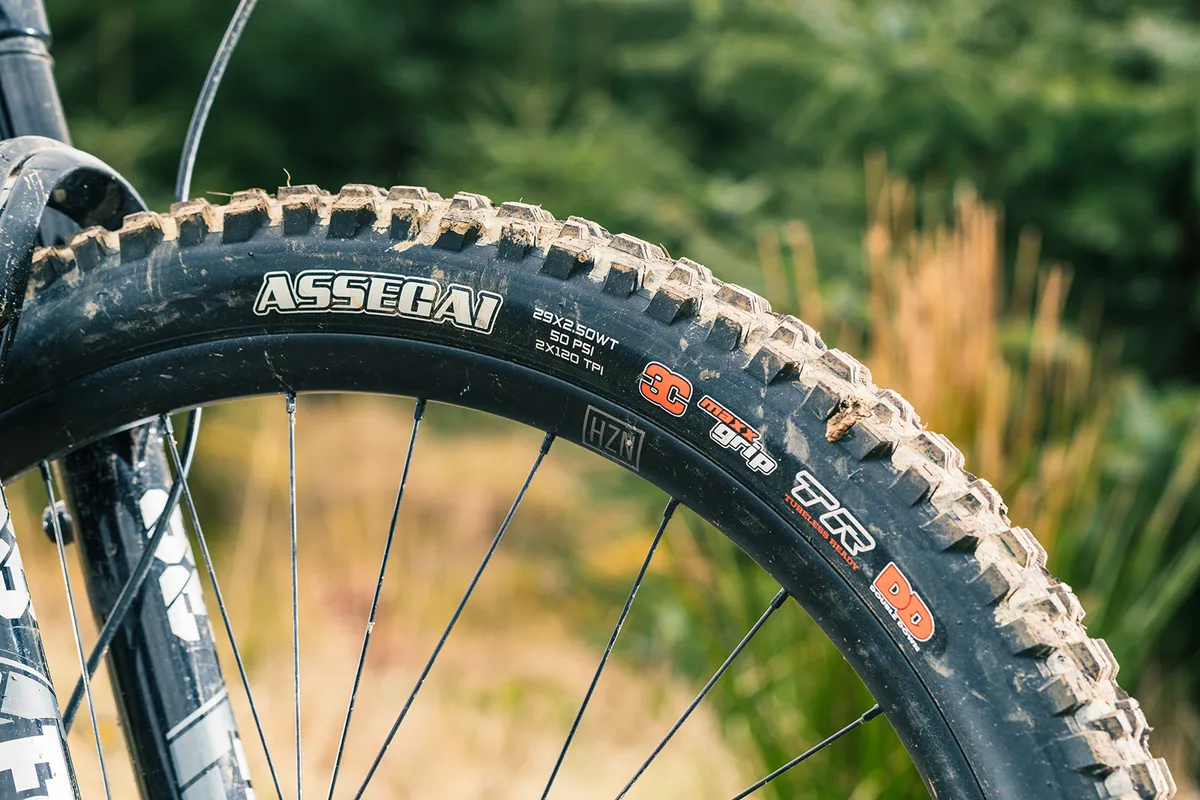
As a result, it’s gone from speccing lighter, more puncture-prone rubber, to full-on race-ready tyres that won’t need changing.
The Elite build seen here (just like the rest of the bikes across the Giga range, apart from the RS, which uses Michelin tyres) comes with a Maxxis Assegai 3C MaxxGrip tyre up front and uses a DoubleDown casing.
At the rear, a Maxxis Minion DHR II 3C MaxxTerra tyre, also with a DoubleDown casing, is ready and waiting for some abuse.
Beneath the tyres sit Nukeproof’s very own Horizon V2 wheels, which proved tough throughout testing. The rear hub has a reassuringly quick pick-up and nice whir to it, too.

On top of that, Nukeproof provides much of the finishing kit, including the bar, stem, saddle and grips. It’s all well-made and nicely finished. If I was to criticise anything, it’d be the dual lockring grips, which feel dated and aren’t as comfy as the single lock-ring grips we’re seeing more of these days.
All in, the Giga 297 Carbon Elite tipped the scales at 16kg (medium, without pedals).
Nukeproof Giga 297 Carbon Elite ride impressions

I rode the Giga on a wide variety of trails, covering everything from smoother jump trails to steep, technical natural tracks covered in rocks and roots. I made sure to get some high-speed, rough-and-ready bikepark laps in for good measure, too.
Setting up the Nukeproof Giga 297 Carbon Elite
Getting the balance of the suspension right was relatively straightforward from the start. I ended up with 83psi in the fork, but with all adjusters (both compression and rebound) completely backed off and fully open.
This enabled me to get the fork to feel just supportive enough and rebounding at my desired speed. While this worked out for me at 68kg (and when riding some faster, drier trails, I’d add a click of damping if needed), lighter riders may struggle.

A single volume spacer in the fork felt just about right, though after I became more confident on the bike and happier at faster speeds as the trails dried out during the test period, I’d be tempted to add another.
At the rear, I settled on 196psi in the shock with a single volume spacer. Low-speed compression was set at 20 clicks from fully closed, while low-speed rebound was 12 clicks.
Nukeproof Giga 297 Carbon Elite climbing performance
With all that travel on tap, you’d honestly expect the Giga to really struggle on the climbs. Don’t get me wrong, this isn’t going to help snag you KOMs every time you point it skyward, but it climbs well enough for a bike like this.
The weighty MaxxGrip DoubleDown front tyre (I’d have settled for an EXO+ casing up front) is a little draggy. On steeper inclines, when really piling the power on through the pedals at slow speeds, the Giga can also hunker down into its travel somewhat.
In these instances, I’d generally reach for the shock lever and firm up the back end. It doesn’t fully lock the shock out, so there’s still some movement – which is a plus if the incline is particularly steep.
On less severe pitches, you can sit and spin a gear just fine with the shock fully open and limited suspension bob, making the most of that steep seat angle. This sits you quite upright, with your hips over the bottom bracket.
The cockpit isn’t as stretched-out as some, but at 172cm (5ft 8in), I found I could ride the medium comfortably for hours on end.
Nukeproof Giga 297 Carbon Elite descending performance
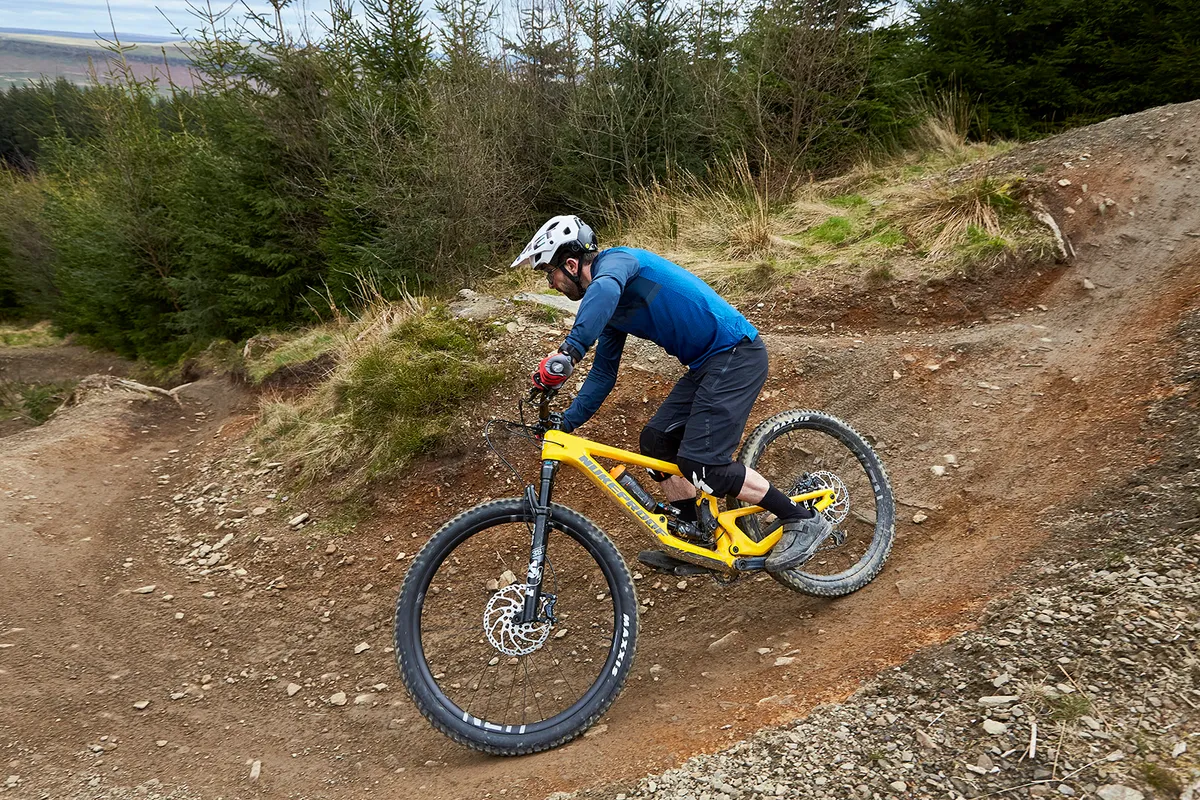
There’s no denying that the Giga 297 feels like a big bike. It’s not that it seems tall and cumbersome in any way. Far from it, thanks to that low-slung centre of mass. But the relaxed head angle, long wheelbase and all that travel make it feel close to a downhill bike in many ways.
It's still though a bike that offers enough urgency when you put the power down, and has the support necessary through the suspension to ensure it’s no soggy mess when riding fast, smooth, flowy trails littered with jumps and berms.
You can loft the front wheel up, chuck the bike about from line to line and make shapes in the air in a very confident manner. Yes, it’ll take a little more muscle to do this compared with some, but we’re not talking big differences here.
That is, in part, down to how well-proportioned the Giga feels and how natural and easy it is to ride. Get it set up, jump on and you’ll be up to speed in no time at all.
Rough and ready

When the speeds increase and the bumps come thicker and faster, the balance and composure of the Giga really starts to shine through.
The bike’s back end is supple enough to track the ground impressively and manages to soak up the chatter well. When the hits get bigger, while the Giga can’t just make these bumps completely melt away (not that many bikes can really do this), it’ll more than just take the edge off to smooth things out. It boosts control and certainly helps maintain speed through flatter rock sections.
In these instances, despite the sensitive initial touch and good mid-stroke support, the Fox 38 doesn’t feel as forgiving as a RockShox ZEB, for example. It’s not a dramatic difference, and generally only something I would start to pay more attention to at the end of a long day on the hill. I think a service and tune-up would remedy this, though.

And when you’re tackling the really high-speed trails that are strewn with loose rock and gravel through the turns, there’s no denying how much confidence the brake and tyre combo brings into play.
Being able to confidently jab the brakes and slow down in what feels like a split second really makes a difference to how you approach a trail. The light touch of the Shimano levers, coupled with their impressive power, really helps when your hands and arms are starting to feel beaten up.
I know I’ve mentioned the front tyre feeling a little slow going on the ups, but there’s no getting away from the fact that it feels reassuringly predictable in just about any conditions. And that counts for a lot.
Edging ahead

Taking the top spot in Enduro Bike of the Year isn’t an easy thing to achieve. So, what made the Giga 297 stand out from the crowd and edge ahead when it mattered most?
Well, it had already impressed on the fast, high-speed trails, but it was when tackling steeper, natural terrain that the Giga 297 managed to outshine the competition.
The Giga’s ability to hold a line and carry speed through a turn is simply astounding. Bank it into a turn and even in those instances when you feel you’ve come in too hot, somehow, the bike will carve its way through without faltering. It keeps the tyres glued to the trail and spits you out the other end at some serious speed.
This balance, pace and traction that you can hold through the corners is simply electrifying and, ultimately, a massive confidence boost where it matters most.
Add to that the overall poise and dynamic position the bike manages to hold when things get really terrifying make it a formidable bit of kit and a bike that I continue to reach for whenever the opportunity arises.
How does the Nukeproof Giga 297 Carbon Elite compare?

Overall, the closest contender to the Giga 297 was the Whyte G-180 RS MX. In fact, when it came to tackling really rough, high-speed sections of trail, the Whyte did at times, have the edge, certainly in terms of comfort and how well it can isolate the rider from impacts.
But it was when riding steeper trails that the balanced feel of the Giga managed to creep ahead and just boost rider confidence that bit further, which means a lot.
Nukeproof Giga 297 Carbon Elite bottom line
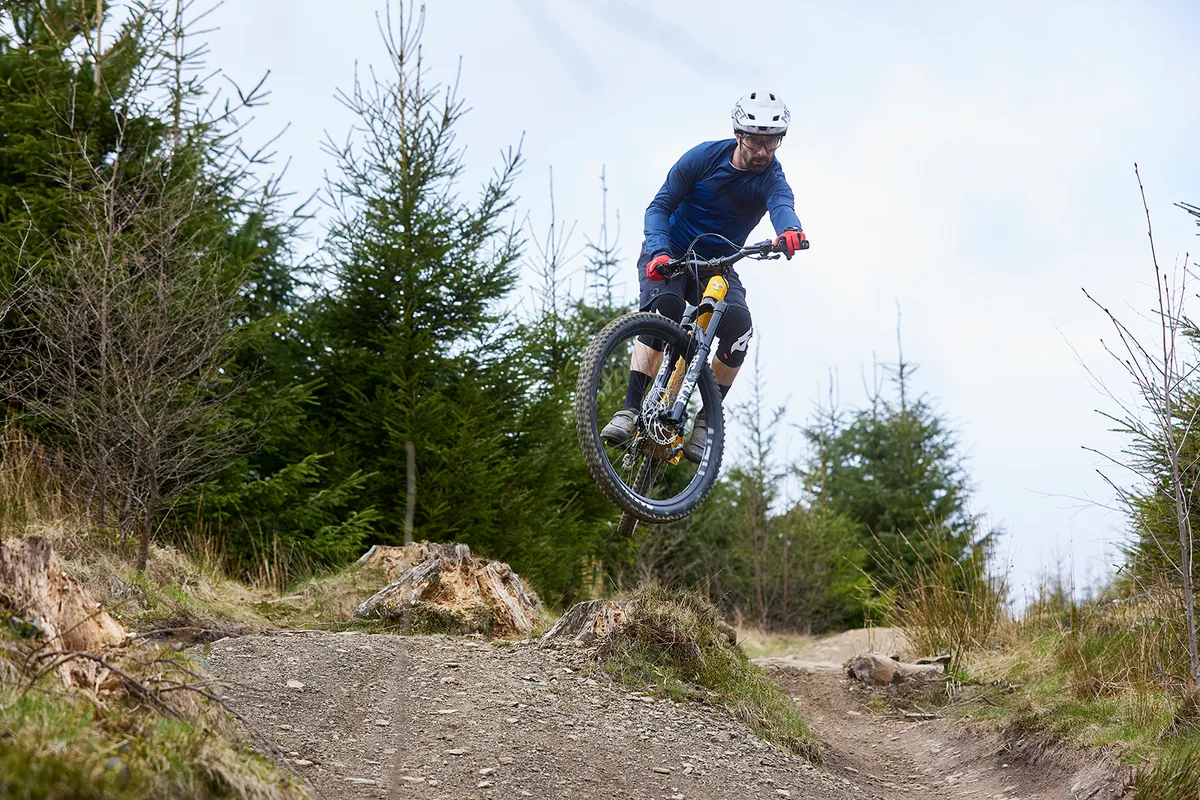
The Giga 297 Carbon Elite isn’t perfect. I’m not saying it is. The fork works well enough, but lighter riders might find it a little over-damped, and it’s not as comfy on the hands when things get really rough.
It isn’t the speediest climber, although it’s still easy-going enough for the most part, even if you do need to flick the shock lever.
Get the bike pointed down pretty much any trail, though, and the balance the Giga exudes, along with the impressive proportions and rear suspension, make it a blast to ride fast.
And through the turns, this thing can simply carve a line harder than most at an astounding pace. It really impresses on every ride.
Enduro Bike of the Year 2022 | How we tested
Designing a high-performance enduro bike is all about balance.
While there’s no denying these bikes need to descend with the confidence and poise of a full-blown downhill bike, they still need to be pedalled back up to the top of the hill.
But, more than that, they also need to be built to last with components that can take a serious beating.
To be crowned as the best enduro bike on test, we were looking for a bike that felt pleasant enough on the climbs (no enduro bike will ever be a cross country-like mountain goat!) and easy to ride fast when pointed back downhill.
Testing the bikes required a serious amount of riding over a 12-week period. The terrain needed to be varied, too. Testing included everything from steep, natural trails covered in roots and peppered with rocks and mud, through to faster, high-speed bike park tracks with wheel-destroying rock gardens and chunky jumps.
We rode all of the bikes on test back-to-back to pin down the differences and mixed up the order in which we rode the bikes to see just how each machine felt when we were fresh – and not so fresh.
Our 2022 Enduro Bike of the Year contenders are:
- Cannondale Jekyll 2
- Canyon Torque CF8
- GT Force Carbon Pro
- Marin Alpine Trail XR
- Nukeproof Giga 297 Carbon Elite
- Propain Tyee AL 29 Performance
- Santa Cruz Bronson C R
- Whyte G-180 RS MX
Thanks to…
Thanks to our sponsors MET Helmets, Bluegrass Protection and BikePark Wales for their support in making Bike of the Year happen.
Product
| Brand | nukeproof |
| Price | 4600.00 GBP |
| Weight | 16.0000, KILOGRAM (M) - without pedals |
Features
| Fork | Fox 38 Performance Elite GRIP2, 180mm travel |
| br_stem | Nukeproof Horizon, 45mm |
| br_chain | Shimano SLX |
| br_frame | Carbon, 180mm (7.1in) travel |
| Tyres | Maxxis Assegai 3C MaxxGrip DD 29x2.5in (fr)/Maxxis DHR II 3C MaxxTerra DD 29x2.4in (r) |
| br_brakes | Shimano SLX M7120 (203mm rotors) |
| br_cranks | Shimano SLX M7100 |
| br_saddle | Nukeproof |
| br_wheels | Nukeproof Horizon V2 |
| br_headset | Nukeproof |
| br_shifter | Shimano SLX M7100 |
| br_cassette | Shimano SLX M7100 |
| br_seatpost | Brand X Ascend, 150mm |
| br_gripsTape | Nukeproof Sam Hill Signature |
| br_handlebar | Nukeproof Horizon V2, 780mm |
| br_rearShock | Fox Float X2 Performance Elite |
| br_availableSizes | S, M, L |
| br_rearDerailleur | Shimano SLX M7100 |
